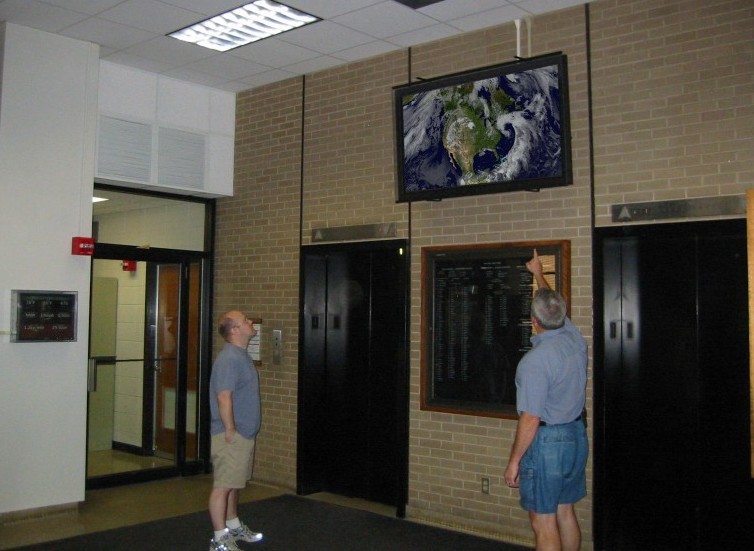
[ Archive ]

 |
CIMSS-NOAA Weekly Report
[ Archive ] |
 |
IN THE PRESS:
Satellite Aviation Weather in the Press: Wayne Feltz (Cooperative Institute for Meteorological Satellite Studies, CIMSS) and Mike Pavolonis (NESDIS at CIMSS) were interviewed for an article that appeared in the June 5, 2006 edition of the Milwaukee Journal Sentinel newspaper. The article highlighted volcanic ash research performed by Pavolonis, and Feltz's convective initiation research performed at the University of Wisconsin-Madison and the University of Alabama-Huntsville. Both research efforts are aimed at using satellite data to improve aviation hazard assessments and forecasts. The article is available at: http://www.jsonline.com/story/index.aspx?id=431047. (M. Pavolonis, E/RA2, 608-263-9597, Mike.Pavolonis@noaa.gov, W. Feltz, CIMSS)
ITEMS FOR THE ADMINISTRATOR:
ITEMS FOR THE ASSISTANT ADMINISTRATOR:
ITEMS FOR THE OFFICE DIRECTOR, STAR:
Intercalibration of GOES-11 with AIRS:
Researchers at the Cooperative Institute for Meteorological Satellite
Studies (CIMSS) captured Geostationary Operational Environmental
Satellite (GOES)-11 Imager pre-operational data as it moves to 135 West
Longitude and compared the GOES data to the Atmospheric InfraRed
Sounder (AIRS) on the polar-orbiting Aqua satellite. The 3.9, 11,
and 12 micrometer bands on GOES-11 compared well, to within 0.5 degrees
Kelvin, to AIRS. Due to gaps in AIRS' spectral coverage, a
comparison with the 6.8 micrometer water vapor band is not feasible,
but there appears to be no reason to believe that the calibration
accuracy of that band is off. The data were acquired by the Space
Science and Engineering Center (SSEC) Data Center. (M. Gunshor, CIMSS,
608-263-1146)
Derived Cloud Top Pressure from GOES-11 Sounder: While the Geostationary Operational Environmental Satellite (GOES)-11 platform is moving to its GOES West location, Sounder data have been processed at the Cooperative Institute for Meteorological Satellite Studies (CIMSS), University of Wisconsin - Madison. A preliminary example of GOES-11 Sounder Cloud Top Pressure (CTP) was compared to the GOES-10 Sounder CTP derived image for 18 Universal Time Coordinated (UTC) on 6 June 6, 2006. Results from the two Sounder instruments are quite consistent, even with different satellite view angles. These data were acquired via the Space Science and Engineering Center (SSEC) Data Center. (T. Schreiner, CIMSS, 608-263-6754, T. Schmit, E/RA2, 608-263-0291, tim.j.schmit@noaa.gov)
Caption: A comparison of GOES Sounder Cloud Top Pressure (CTP) between the GOES-10 and -11 Sounders CTP derived image for 18 Universal Time Coordinated (UTC) on 6 June 2006. Preliminary results between the two Sounder instruments are quite consistent.
ITEMS FOR THE DIVISION CHIEF, CoRP
Another OWL on the University of Wisconsin-Madison Campus:
Following the successful implementation last year (April 2005) of the
On-line Weather Looper (affectionately referred to as the
“OWL”) in the lobby of the University of Wisconsin-Madison
(UW) Atmospheric, Oceanic, and Space Sciences (AOSS) Building, a second
display has been added on campus, in Bascom Hall, outside the office of
the Dean of the Graduate School and Vice Chancellor for Research (Dr.
M. Cadwallader). Although smaller than the 60” plasma
screen prominently mounted in the AOSS lobby (see figure), the second
OWL display, installed this week, is formidable for its location, being
a 32” liquid crystal display (LCD). This highly visible
effort, the joint work of more than a dozen technicians and scientists,
from both the UW Space Science and Engineering Center (SSEC) and the
Cooperative Institute for Meteorological Satellite Studies (CIMSS),
highlights, and promotes understanding of, satellite data for
applications to various aspects of weather. An interactive keypad
for the AOSS lobby unit allows viewers to select from the suite of
current animations, which continues to evolve with new products and
displays provided by collaborators, such as the UW Department of
Oceanic and Atmospheric Sciences and the SSEC MODIS (Moderate
Resolution Imaging Spectroradiometer) team. (W. Bellon, CIMSS,
608-263-6726, G.S. Wade, E/RA2,
608-263-4743, gary.s.wade@noaa.gov)
 (Click image to enlarge)
(Click image to enlarge)
Manuscript Review: J. Key reviewed a manuscript on trends in Arctic climate for Geophysical Research Letters.
(J. Key, E/RA2,
608-263-2605, jeff.key@noaa.gov)
Other Meetings and Telecons:
(None)
VISITORS:
NEXT WEEK:
EUMETSAT Conference: T.
Schmit and J. Key will attend the 2006 EUropean organization for the
exploitation of METeorological SATellites (EUMETSAT) Meteorological
Satellite Conference to be held in Helsinki, Finland, next week. J. Key
will give a keynote presentation titled "A new view of the polar
regions from space: Improving weather forecasting and understanding
climate change". T. Schmit's presentation is titled "2006
update on baseline instruments for the Geostationary Operational
Environmental Satellite (GOES)-R series". (T. Schmit, E/RA2,
608-263-0291, tim.j.schmit@noaa.gov)
LOOKING AHEAD: